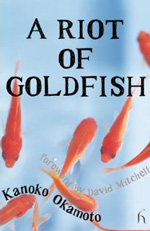
This edition of A Riot of Goldfish, with its terrifically alluring cover, comprises two stories. The first shares its title with the book, and the second is "The Food Demon," which is translated here for the first time. Both stories are set in pre-World War II Japan, and both centre on two lower class men who try to improve their lives but instead get lost in their obsessions. For some reason when I picked up A Riot of Goldfish, I expected a new novel set in 21st century Japan. You can imagine my surprise then at discovering in the forward by David Mitchell (of Cloud Atlas fame) that Kanoko Okamoto was born in 1889 and is considered "a minor but unforgettable" contributor to Japanese literature. After reading descriptions of her "decadent aestheticism" and "overwrought" style, I admit I felt a little daunted to start this book. In the future I must remember that introductions and forwards are best read at the end of a book, when the reader can put them in context. It turns out there was absolutely nothing daunting about this book
The story "A Riot of Goldfish," traces Mataichi, the son of a goldfish breeder, through his lifelong struggles with his unrequited love for the daughter of the family's patron. He loves Masako, but she loves goldfish. One day when they are young adults, she tells him: "I think goldfish are the freest and most beautiful creatures people can make." Masako's suggestion that goldfish are free is interesting comment. For the most part, she appears to swim through her life unconcerned with much. Like goldfish in a pond, Masako is free—free from working to support her family, free from duty, and free from any purpose other than to be beautiful. But like the goldfish, she floats around in her small world, seemingly unaware of anything beyond her own pond. There is no freedom to be anything else.
Initially, Mataichi is indifferent to the goldfish that are so important to the people in his life. Then Masako explains how "people have lived and died for goldfish," referring to the fin de siécle Japanese who traded the creatures with a fever similar to the Dutch who traded tulip bulbs in the 17th century. Eventually, Mataichi begins "to see in goldfish the shape of life itself." He gradually becomes a recluse, obsessed with creating a "precious, beautiful new breed of goldfish like none the world has ever seen." Breeders before him had lost their minds to goldfish fever, and now he believes his quest makes him a tragic "nameless hero caught up in a mysterious fate." To compensate for his inability to marry, Mataichi instead sets out to make a goldfish as beautiful and ethereal as Masako. The story drifts along, furling and unfurling like a gossamer tail, until it concludes in an unexpected tempest. What makes this piece work is Okamoto's gentle play of imagery, symbolism and poetic language. After reading the story, I felt as if I'd spent a dreamy afternoon watching goldfish in a pond.
The main character in "A Riot of Goldfish" is antisocial, but Besshirō from "The Food Demon" is outright malicious. In the introduction, the translator explains how he could have also translated the title, Shokuma, as "The Gourmet." Instead, he went with the direct translation, as he believed it was Okamoto's intention to help stress Besshirō's bad character—he is indeed a bit of a demon. Besshirō is bitter about his lot in life and place in society, and tries to earn the honorific of "Sensei," at first through traditional art and then by way of his mastery as a chef. He befriends another epicurean, an older well-travelled man named Hagaki. Together they share hedonistic pleasures, discuss philosophy, and lament how they had both "been brought up among the lower classes by mistake." Throughout the story, the characters often convey a sense of resignation with their situation in life. Besshirō repeatedly justifies his poor behaviour with the excuse that "it can't be helped." This hopeless attitude, along with the ugly details of life in Besshirō's world, make "The Food Demon" a less pleasant read than "A Riot of Goldfish." What the story lacks in levity, though, it makes up for with complex character development and narrative movement, and perhaps even a little dark humour.
In the end, this is the type of literature where the meaning is left to the reader. In the forward, Mitchell
says that "Okamoto is more concerned with themes of aesthetics and the artist than with class consciousness,
female liberation or the politics of the expanding Japanese empire." However, the publisher contradicts this,
by printing on the book's back flap: "her prose works examine the relationships between the classes and sexes
in her contemporary Japan." Rather than working in oils or pastels, Mataichi and Besshirō are artists
who work in goldfish and food. Yes, aesthetics play a major part in both stories, but it can't be denied
that they are also about the relationships between the social classes of 1930s Japan. As that is a place
I had yet to visit in my literary travels, I found "A Riot of Goldfish" an interesting and worthwhile read.

Hesperus Press, paperback, 9781843918523
